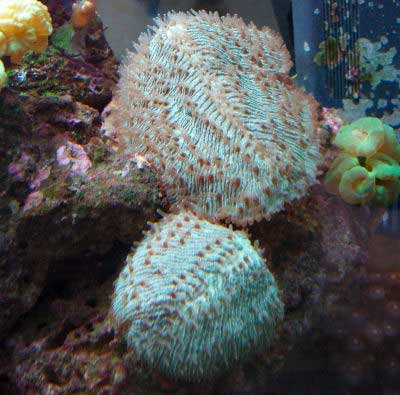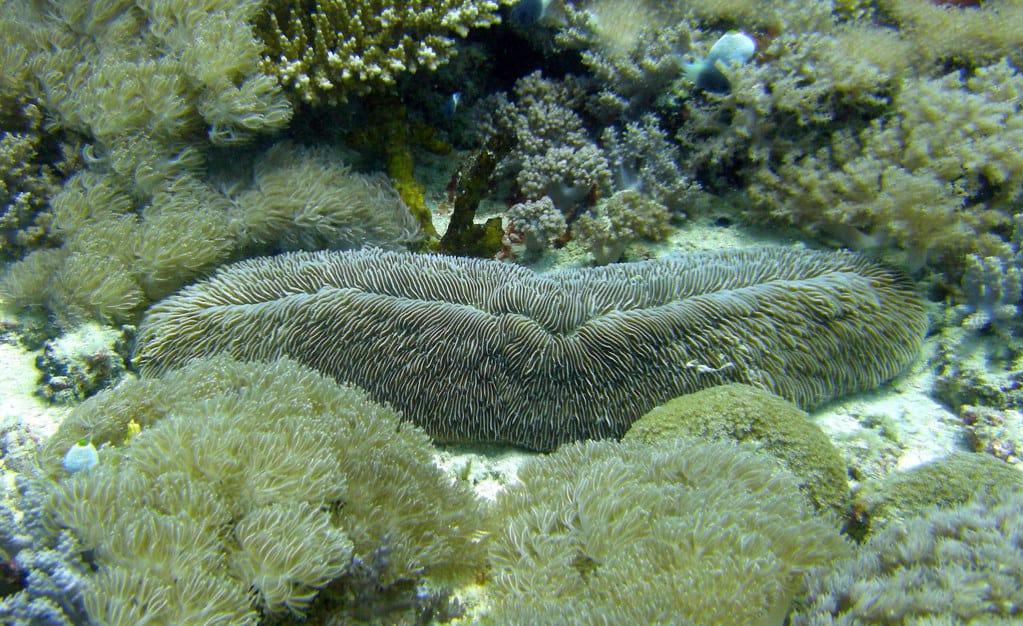
The Tongue Coral not only resembles a tongue, but is the largest of the solitary corals!
The Tongue Coral Herpolitha limax has a most descriptive common name, because it looks like an extended tongue. These corals are flat, or arched when viewed from the side, and can form several shapes. They can be shaped like a tongue, a boomerang, or a T, X, or Y shape. The Herpolitha genus are the largest of all the solitary corals, and can reach 39″ (1 m) or more in the wild. Some other common names they are known by are Slipper Coral, Mole Coral, Hedgehog Coral, and Striate Boomerang Coral.
The Tongue Coral has a prominent central groove down the middle, called an axial furrow. There are mouths (called polystomatous) along this furrow and several more mouths across the surface. Their tentacles, more like inflated tissue than a tentacles, are short and widely spaced between broad septal ridges that radiate out from the furrow. Feeder tentacles come out at night. Their colors are predominately brown, cream, or shades of green. Occasionally the tentacles can contrast slightly from the rest of the coral, usually being white or green.
The Tongue Coral is similar in appearance to the Slipper Coral Polyphyllia talpina, but there are some distinct differences. On the Polyphyllia corals the central furrow is only a small indentation and they have many tentacles, giving them a shaggy or mop-like appearance.
The Tongue Coral is quite hardy, more so than many of the other solitary corals. It can be easy to care for if it has the proper substrate and placement, proper lighting and water movement, and regular daily feeding. Provide it with an adequate sized aquarium, as Herpolitha spp. can get quite large. This coral also has a net-like mucus secretion (with stinging nematocysts) that it uses to feed and for protection. Fortunately its mucus is not as powerful, or as dangerous to nearby corals, as other Fungiids. A curiously different, yet attractive animal for a dedicated reef keeper.
Scientific name
Family: Fungiidae
Species: Herpolitha limax
Distribution / Background
Herpolitha Coral Information: The Family Fungiidae which all Herpolitha spp. corals belong is credited to Dana in 1846. The Herpolitha genus was described by Eschscholtz in 1825, and the Tongue Coral Herpolitha limax was described by Houttuyn in 1772. There are 9 nominal species, two of which are true species, with both being found around Australia. The true species are: H. limax and H. weberi. Some common names these corals are know for are Slipper Coral, Mole Coral, Hedgehog Coral, and Striate Boomerang Coral.. The Herpolitha genus has been propagated in captivity.
Where Herpolitha Corals Are Found: The Herpolitha genus are found in the Indo-West Pacific and Red Sea, including western, northern, and eastern coasts of Australia east to Tahiti, and north to Ryukyu Islands. The Tongue Coral H. limax is found from the Red Sea to the Tuamotu Archipelago and around Australia from the Great Barrier Reef and the Coral Sea in the east, and south to the North West Cape on the west coast.
Herpolitha Coral Habitat: The Herpolitha genus inhabit reef slopes, on flat areas between the lagoons and the reef. They are found on soft bottoms and rubble that are in areas protected from strong water movement. They are typically found in slightly deeper waters than other Fungiids. They are abundant and widespread in the wild.
Status
The following species from this genus are on the IUCN Red List of Endangered Species:
- Herpolitha limax: Least Concern (LC)
- Herpolitha weberi: Least Concern (LC)
Description
What do Herpolitha Corals look like: The Herpolitha genus are flat, or arched when viewed from the side, and can form several shapes. They can be shaped like a tongue, a boomerang, or a T, X, or Y shape. The Herpolitha genus are the largest of all the solitary corals, and can reach 39″ (1 m) or more in the wild.
The Herpolitha genus have a prominent central groove down the middle, called an axial furrow. There are several mouths (called polystomatous) aligned with the central axis and more mouths across their surface. Their tentacles are short and widely spaced, looking more like inflated tissue rather than standard tentacles. They are nestled between widely spaced round-ridged septal teeth that radiate out from the central axis.
The Tongue Coral H. limax can be distinguished from the Polyphyllia corals because they don’t have the deep and prominent central groove down the middle like the Herpolitha genus does. Rather they do have a small indentation, or furrow, that runs down the center. Also the Polyphyllia corals have many more tentacles that give it a shaggy or mop-like appearance.
The colors of the Herpolitha genus are predominately brown, cream, or shades of green. Occasionally the tentacles can contrast slightly from the rest of the coral, usually being white or green.
Difficulty of Care
Herpolitha Coral Care: The Tongue Coral H. limax can be easy to care for if it has the proper substrate and placement, proper lighting and water movement, and regular daily feeding. The Herpolitha genus is quite hardy, more so than many of the other solitary corals.
Fungiids usually do fine for some time but then can suddenly die, often for no apparent reason. Once cause of their demise is aquarists placing them on the rock work. This results in falls and/or causes tissue laceration, infection, and death. Another problem is with not feeding them enough, they must be fed daily to thrive in the aquarium.
Foods / Feeding
Herpolitha Coral Feeding: The Herpolitha corals, like other large polyp stony (LPS) corals, have developed several feeding strategies. Through a symbiotic relationship with a marine algae, known as zooxanthellae, they receive many of their nutrients. They also capture planktonic organisms, food particles from the water column, and can absorb dissolved organic matter.
In captivity, the Tongue Coral needs to be fed at least daily. They also need to be fed more often under lower lighting conditions. Fungiids form mucous nets, at that time that you can put small amounts of shredded meat on this net. They can be fed shredded meat, as well as mysis and brine shrimp. With larger foods, try to feed the whole organism to the coral. For instance if you are feeding it a silverside, chop it up but feed it all, so your Tongue Coral will get the fullest nutritional benefit from the meal.
Aquarium Care
Typical water changes of 20% a month, 10% biweekly, or 5% weekly are needed. It has been noted that 5% weekly water changes replenish many of the needed additives and it is ultimately cheaper than purchasing additives for the water. With higher concentrations of coral with calcareous skeletons though, there may be a need put in additional additives to maintain proper levels for good growth.
The following water supplements are suggested for Herpolitha species:
- Calcium: 400 to 430 ppm. If a large poly stony (LPS) coral does not have enough calcium, it will not grow. (Seachem makes a calcium additive that states 385 as sufficient)
- Alkalinity: 3.5 MEQ/L (8 to 11 dKh, 10 is recommended)
- Phosphates: 0, zero. Phosphates are the worst of all and all corals hate them.
- Magnesium: 1200 – 1350. Magnesium makes calcium available, so if your calcium is low, check your magnesium levels before adding any more calcium.
- Strontium: 8 – 10
Aquarium Parameters
A well-feed live rock/reef environment is what is needed for your Tongue Coral , along with some fish for organic matter production. Have an open area of soft substrate or a rubble bottom for this animal, and do not put it on rock work.
| Quick Ref Chart | |||
|---|---|---|---|
| Lighting: | |||
| Water Flow: | |||
| Temperament: | |||
The Tongue Coral is easily kept in the home aquarium as long as it is placed on a soft or rubble-covered bottom, given a slow and gentle current, and bright light. The Tongue Coral H. limax does not attach to a surface (rock, substrate, etc.). It is quite capable of movement and may move itself around a tank to find its own favorable position (as will other fungiids). Though peaceful with other Fungiids, this coral can be semi-aggressive toward other corals. It needs to be placed where it cannot ‘walk’ up to corals that are not in the Fungiidae family
- Minimum Tank Size / Length: 50 gallons (190 L) or larger
- Marine Lighting: Moderate to high, Herpolitha spp. do contain zooxanthellae
- Temperature: 74° – 83° F (23° – 28° C)
- Salinity / Specific Gravity: 1.023 – 1.026
- Water Movement: Low to moderate, but not strong enough to remove the feeding mucous net.
- Water Region: Bottom of the aquarium
Compatibility and Social Behaviors
Herpolitha coral is peaceful with all the genus and species within the Faviidae family, however they can be aggressive toward other corals. This coral also has a mucus secretion, that it uses to feed and for protection. But fortunately its mucus is not as powerful and dangerous to other near by corals as other members of the Fungiidae family.
Sex – Sexual differences
Breeding and Reproduction
The large polyp stony (LPS) corals are male and female and can reproduce both sexually and asexually. In the wild they reproduce sexually by releasing eggs and sperm at the same time, resulting in a fertilized egg which then forms into a free-swimming planula larva. Eventually the planula larvae settles onto the substrate, becoming plankters. This then forms a tiny polyp which begins to excrete calcium carbonate and develops into a coral. Planula larvae are extremely vulnerable to predation, and very few survive. The Herpolitha genus will also reproduce asexually. Daughter colonies/polyps may form and they will form offspring from broken pieces
In captivity, propagation of H. limax can be done by encouraging budding of daughter colonies by scoring the tissue in between the “teeth” of the coral. Make sure the animal has been well fed and is healthy before attempting this type of fragmentation. Simply breaking the coral in half with gloves, using a wedge and hammer is crude, but works. To get a cleaner, more precise frag, using a dremel or other motorized saw works beautifully. You can cut pie shaped frags from a whole animal if you wish and they respond quite well as long as they can recover in clean water and are well fed.
Potential Problems
The Herpolitha genus should not be expanded when removing it from the water. Make sure to gently shake the coral until the tissue has receded before exposing it to the air. If they are not fed, they will die, since they have carbon requirements.
Availability
Herpolitha Corals for Sale: The Tongue Coral H. limax is very easy to find at pet shops and on line. Online they can run about $20.00 to $50.00 USD or more depending on size and/or color.
References
- Animal-World References: Marine and Reef
- Eric Borneman, Aquarium Corals: Selection, Husbandry, and Natural History , TFH Publications, 2001
- J.E.N. Veron, Corals of Australia and the Indo-Pacific , University of Hawaii Press; 2 Rev Ed edition, 1993
- Bob Goemans, Tongue Coral, Slipper Coral, Mole Coral, Herpolitha limax, Animal Library, Saltwatercorner.com
Featured Image from Openverse
